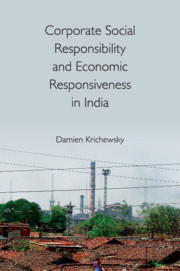Book contents
- Frontmatter
- Contents
- List of Tables and Maps
- List of Abbreviations
- Preface
- 1 Introduction
- 2 CSR, Functional Differentiation, and the Problem of Economic Responsiveness
- 3 Economic Differentiation and the Rise of India's ‘Embedded’ Corporate Capitalism
- 4 Increasing Functional Differentiation and the Rise of CSR
- 5 CSR at Work: Economic Responsiveness through Risk Management
- 6 India's CSR Public Policies and the Politics of Economic Responsiveness
- 7 Conclusion
- References
- Index
5 - CSR at Work: Economic Responsiveness through Risk Management
Published online by Cambridge University Press: 26 April 2019
- Frontmatter
- Contents
- List of Tables and Maps
- List of Abbreviations
- Preface
- 1 Introduction
- 2 CSR, Functional Differentiation, and the Problem of Economic Responsiveness
- 3 Economic Differentiation and the Rise of India's ‘Embedded’ Corporate Capitalism
- 4 Increasing Functional Differentiation and the Rise of CSR
- 5 CSR at Work: Economic Responsiveness through Risk Management
- 6 India's CSR Public Policies and the Politics of Economic Responsiveness
- 7 Conclusion
- References
- Index
Summary
To grasp how CSR, conceived of as an intermediary institution, has emerged from and retroacted on the way society responds to tensions and conflicts between profit-driven economic processes and other spheres of society, studying companies seems to be an obvious area of investigation. Indeed, companies operate at the crossroads between the economy and other function systems, and the introduction of CSR in their organizational structures and processes can be expected to change economic responsiveness vis-à-vis problems located in other spheres of society.
Business organizations and the interplays between the economy and other spheres of society
In the framework of SST, companies as organizations constitute a specific kind of social system that operates on the basis of decisions. Of course, organizations involve human participants in the communicative production of decisions. But decisions are not intentional acts of individual human decision-makers. Decisions consist in the combination of two selections: the selection of a set of alternatives and the selection of one of these alternatives as the ‘decision’. As such, decisions constitute the building blocks of organizations, and organizations reproduce themselves by maintaining the self-referential and autopoietic process of decision-making. More concretely, once an initial decision has been taken to create an organization, this decision creates the conditions for further decisions to be taken – about the legal status of the organization, its name, its internal structure of positions and the related division of tasks, the recruitment of members, and so on. Each of these decisions keeps the organization going and creates the conditions for further decision-making.
In this framework, unlike function systems, organizations do not operate along a binary code such as paying/not paying (the economy), powerful/powerless (politics), legal/illegal (law), true/false (science), and so on. Their decisions are guided by ‘decision premises’ that reduce uncertainty by structuring and stabilizing the organization's decision-making processes. For instance, a company's strategy, its internal policies, or its annual budget are premises that structure and orient – without determining – a multitude of other decisions. Similarly, personnel decisions about recruitment and assignment of tasks structure a multitude of further decisions regarding the internal division of labour. And decisions on communication channels, such as hierarchical chains of command, define which decisions are expected to be considered as premises for which decision-making situation.
- Type
- Chapter
- Information
- Publisher: Cambridge University PressPrint publication year: 2019

